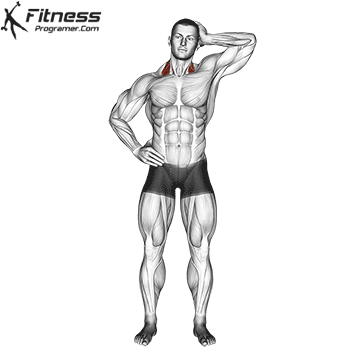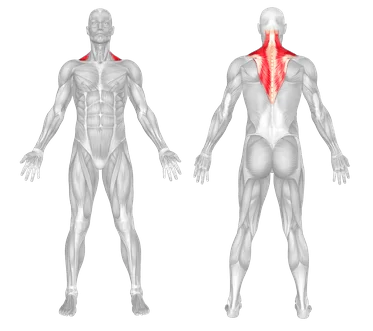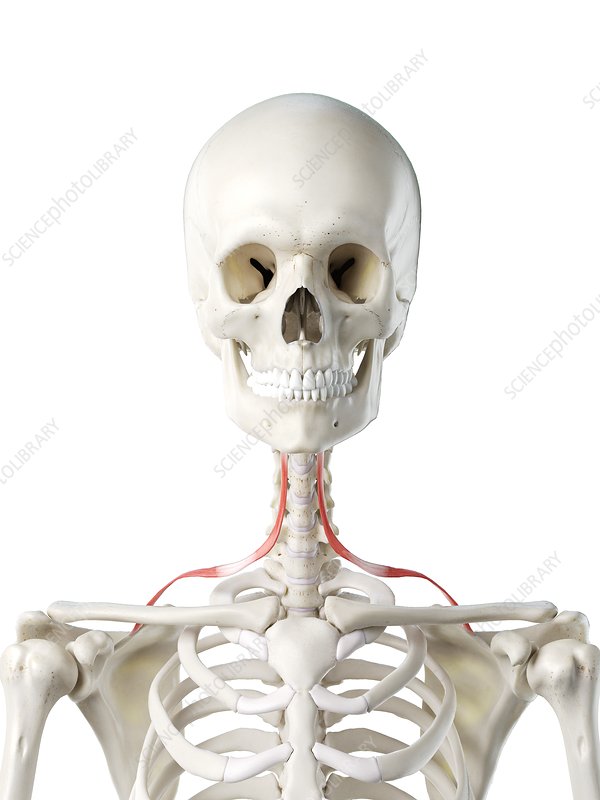About the exercise
Description
The lateral neck stretch, or neck stretch with side pressure, is a simple and effective exercise for reducing tension and stress in the neck muscles, especially the scalenes and sternocleidomastoid. This exercise helps improve neck flexibility, reduce pain caused by poor posture, and relieve tightness in the shoulder and neck muscles.
Regularly performing these lateral and diagonal stretches can increase neck range of motion and reduce discomfort caused by prolonged sitting or occupational stress. It is recommended to include this exercise in your daily routine, especially if you spend long hours sitting or working at a desk.
Preview

How to perform the exercise

Preparation
Sit or stand upright with your shoulders relaxed and down in a natural position.
Execution method
- Tilt your head to one side (bringing your ear toward your shoulder).
- With your opposite hand, gently apply light pressure in the direction of the tilt.
- Hold this position for 15–30 seconds, then repeat on the other side.
Coaching tips and recommendations
Keep your back straight and your shoulders relaxed and in a natural position while performing the exercise.
Avoid sudden or jerky movements; the stretch should be performed with gentle and gradual pressure.
Stretch only to the point where you feel a mild stretch. Avoid causing pain or excessive pressure.
Breathe deeply and slowly while holding the stretch to help your muscles relax more effectively.
If you have a neck injury, cervical disc issues, or any unusual pain, consult your doctor or physiotherapist before doing this exercise.
Focus on the muscles being stretched to improve your body awareness and control during the movement.
This exercise is very helpful for relaxing the muscles and improving neck range of motion, especially for people who spend long hours at the computer. 😊
Benefits of the exercise

Reduction of pain and muscle tension
Neck stretching exercises help reduce tension and pain in the neck and shoulder muscles, especially for people who spend long periods in a fixed position (such as working at a desk).
Improved flexibility and range of motion
These exercises help increase the flexibility of the neck muscles and ligaments, improving neck range of motion, which is highly effective for daily activities and injury prevention.
Posture correction
Neck stretching exercises can help relieve tightness and shortening of muscles caused by poor posture (such as rounded shoulders and forward head position), and improve the alignment of the neck and spine.
Stress reduction and improved relaxation
These exercises reduce tension in the neck and head muscles, enhancing the feeling of relaxation. They can also help reduce tension headaches.
Muscles involved in the exercise
List of muscles involved

Instruction on the involved muscles
1. Levator scapulae
Levator Scapula
Location: This muscle originates from the transverse processes of the cervical vertebrae (C1 to C4) and attaches to the medial border of the scapula.
Function: Responsible for elevating the scapula and assisting in lateral and rotational movements of the neck
During the stretch: This muscle is stretched when tilting the head to one side (such as bringing the head toward the opposite shoulder). This stretch helps reduce tension in the shoulder and neck area.
Image of the levator scapulae muscles

2. Scalene Muscles
Middle Scalene
Location: Originates from the transverse processes of the cervical vertebrae (C2 to C7) and attaches to the first rib.
Function: Assists in lateral flexion of the neck and helps elevate the rib cage during inhalation.
During the stretch: When the neck is tilted to the side, this muscle, along with the anterior scalene, is stretched and helps improve the lateral flexibility of the neck.
Anterior Scalene
Location: Originates from the transverse processes of the cervical vertebrae (C3 to C6) and attaches to the first rib, positioned in front of the middle scalene.
Function: Assists in neck flexion and rotation, and also elevates the first rib to aid in breathing.
During the stretch: This muscle is stretched when the neck is tilted backward or to the side, which helps reduce tightness in the front of the neck.
Image of the scalene muscles

3. (Sternocleidomastoid - SCM)
Sternocleidomastoid
Location: Originates from two areas:
Sternal head: from the sternum
Clavicular head: from the clavicle
The muscle attaches to the mastoid process of the temporal bone.
Function: This muscle is multifunctional:
Flexes the neck forward
Rotates the head to the side
Stabilizes the head in an upright position
During the stretch: Stretching occurs by tilting the neck toward the shoulder or rotating the head backward and to the opposite side. This movement helps reduce muscle tension and stiffness.
Image of the sternocleidomastoid

4. Omohyoid
Omohyoid
Location: This thin and long muscle originates from the hyoid bone in the neck and attaches to the scapula. It has two parts: the superior belly and the inferior belly.
Function: Helps stabilize and depress the hyoid bone and plays a role in the swallowing process.
During the stretch: This muscle is gently stretched during lateral neck stretches or when lowering the head with side bending.
Image of the omohyoid

5. Trapezius
Trapezius
Location: This large superficial muscle originates from the base of the skull and the processes of the cervical and thoracic vertebrae, and attaches to the shoulders and spine.
Function:
Upper part: Elevates the shoulders and assists in neck movements
Middle part: Retracts the scapulae (shoulder blades)
Lower part: Depresses the scapulae (shoulder blades)
During the stretch: The upper part of this muscle is stretched during lateral neck stretches and can help relieve tension caused by prolonged sitting or stress.
Image of the upper trapezius

Pelank Life | Body Health Assessment
The Best Body Health Calculators Using Scientific Methods
Developed by Pelank Life ©